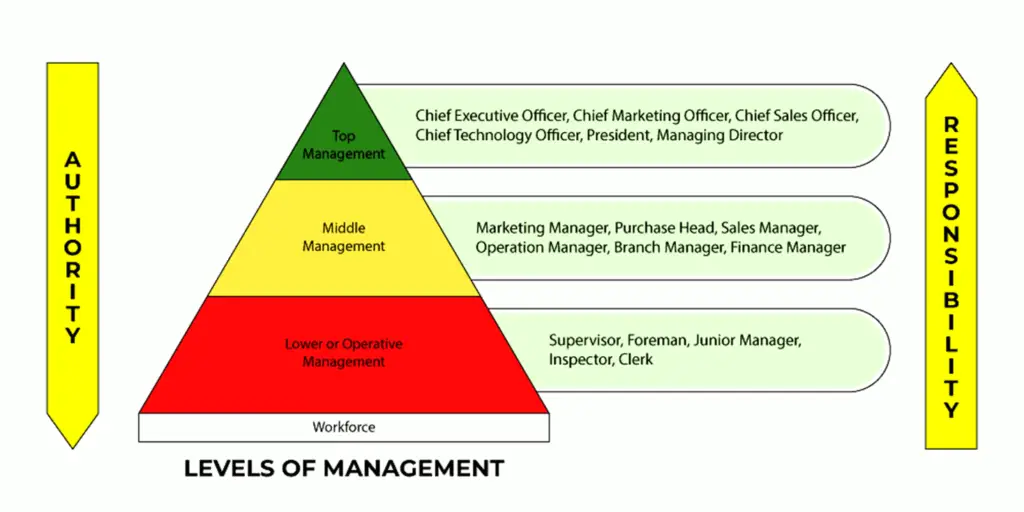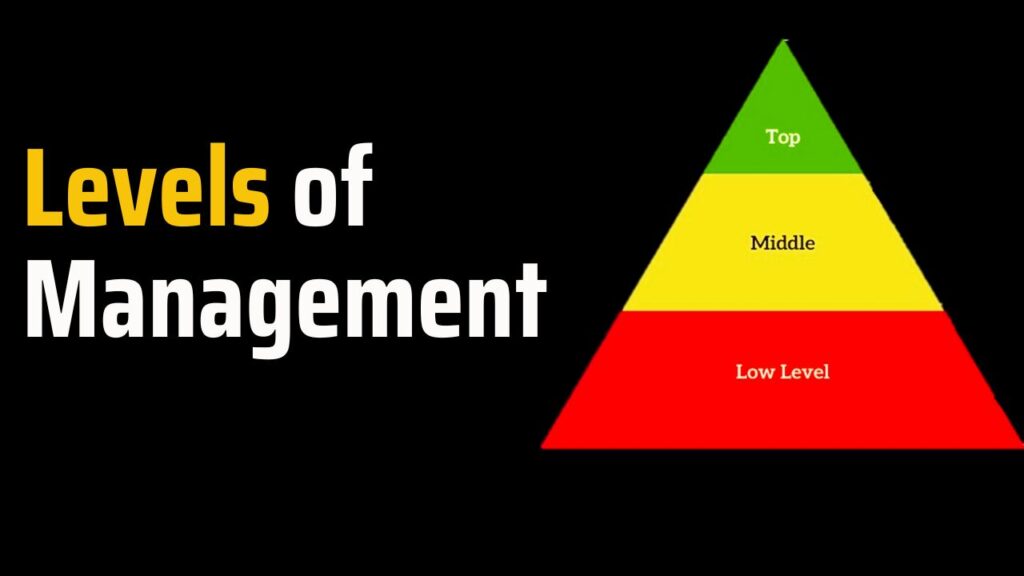Managers are senior staff members that direct employees and make decisions on behalf of the entire organization, a specific branch, or a team within a branch. In organizations with large staffing numbers, several branches, or large teams, managers may hold various levels of responsibility.
Your career path as a manager can be determined by your understanding of various levels of management.
In this article, we will delve into each level, exploring their functions, roles, and significance in organizational dynamics.
Levels of Management
The division between different managerial positions within an organization is referred to as the “Levels of Management.”
The number of management levels increases in line with the company’s growth and workforce, and vice versa. The various levels of management can be used to determine the hierarchy within an organization, as well as the degree of authority and general influence over decision-making that each managerial position possesses.
Three main categories can be used to broadly classify levels of management, each of which assigns managers to carry out distinct tasks.
The precise meaning of these levels and the tasks and responsibilities of the managers who fit into these groups will be discussed in this article.

1. Top-Level Management
The chief executive officer, or managing director, and the board of directors of an organisation make up this level of management. Since it is in charge of an organization’s objectives, policies, and practices, it is the ultimate source of power and authority. The strategic planning and execution of overall business success is their top priority.
This level is responsible for setting the overall direction of the organization and ensuring its long-term success.
Functions of Top-Level Management
- Top-level managers establish the overarching objectives and mission of the organization.
- They formulate broad policies that guide decision-making at all levels.
- Overseeing the coordination and control of activities across various departments. Putting in place controls across all organizational departments.
- Developing strategic plans to achieve organizational goals.
- Maintaining communication with external stakeholders and shareholders.
- Selecting the executives who will oversee departmental managers in middle management.
- Providing overall guidance, leadership, and fostering collaboration within the organization. Providing general direction and guidance as well as promoting harmony and collaboration.
- The top management level of an organization is accountable to its shareholders for the enterprise’s success and is in charge of communicating with the outside world because it comprises the Board of Directors.
2. Middle-level Management
The middle management level is composed of departmental and branch managers. These individuals spend more time on organizational and directional tasks and are directly responsible to top management for the functioning of their departments. Larger businesses can see senior and junior levels within this middle section, but smaller organizations often only have one layer of middle management.
Functions of Middle-Level Management:
- Interpreting policies from top-level management to lower-level management.
- Selecting suitable operative and supervisory personnel through recruitment.
- Assigning duties and responsibilities to lower-level management.
- Motivating employees to achieve organizational objectives.
- Cooperating with various departments for organizational efficiency.
Middle-level managers play a crucial role in translating strategic plans into actionable tasks, fostering a bridge between vision and execution.
3. Lower-level Management
Lower-level management, sometimes referred to as supervisory or operational-level management, is the last level of management. Supervisors, foremen, section officers, superintendents, and all other executives make up this level of management.
Their primary responsibilities are managing human resources and providing guidance to operational staff. In other words, lower-level managers are mostly focused on the day-to-day process execution and coordination that ensure project completion and meetable deliverables.
Functions of Lower-Level Management
- issuing orders and instructions to workers for task execution.
- Planning day-to-day activities and assigning work to subordinates.
- Assisting in work procedures and problem-solving.
- Representing workers’ grievances to middle-level management.
- Ensuring a safe and conducive work environment.
- Encouraging employees to take initiative and rewarding contributions.
- Carrying out the organization’s plans in accordance with the guidelines and instructions provided by top management.
- Making plans for the sub-units of the organization that they supervise.
- Taking part in lower-level management hiring and training processes.
- Interpreting and illustrating the policies for lower-level management from the top-level management.
- Delivering data and reports to upper management in an efficient and timely manner.
- Assessing junior managers’ work performance.
- Encouraging managers at lower level towards improving their performance.
Lower-level managers are crucial in maintaining a positive work environment, executing tasks efficiently, and serving as a direct link between management and employees.
Conclusion
Across a range of titles, authority levels, and levels of the management hierarchy that we depicted above, an organization can have a large number of different managers. To effectively allocate tasks and responsibilities to all managerial positions, it’s critical to understand the main differences between middle-level, low-level, and top-level management.
Every firm has a wide range of different managerial responsibilities. An organization can be very effective at producing value through the creation of its goods, services, and general workflow when these are well coordinated and have a strong hierarchical management system in place.
FAQs
What skills are necessary for success at different management levels?
A career in management necessitates the ability to oversee staff members and give precise, helpful directions for your department within an organization.
The following are some useful management skills:
Communication: Effective verbal and written communication is essential for comprehending the needs of both your staff and your business. As a manager, you could work with other managers, external companies, or clients by using your communication skills.
Quick-Thinking: Being able to think quickly comes in handy when making decisions that need to be made quickly. Quick thinking is necessary at every level of management to address unforeseen problems, respond to customer complaints, and maintain the organization’s progress towards its objectives.
Observation: You may learn a lot about how to improve your business by keeping an eye on details like client behaviour, production issues, and employee performance. This can improve the effectiveness of your systems, boost revenue, and improve the reputation of your business.
Organization: Being organised makes it easier for you to carry out your management responsibilities and guarantees that you remember to finish crucial tasks. Your business and the employees will profit from this since they can perform more effectively when management gives them concise, clear directions.
Leadership: Leadership: It’s critical that you guide your team members to complete tasks that will benefit the business. Making decisions that benefit everyone requires leadership skills, including taking your employees’ opinions into account.
How can you progress in your profession through the management levels?
There are a few standard paths to career advancement in management, while specific fields may have unique qualifications for positions at different management levels. Before taking a position as a first-line manager, obtain some fundamental experience in your field.
You might advance to mid-level and eventually top-level management as you develop your leadership experience and gain knowledge of the company. It could take more training or specialized experience to advance to top-level management positions and demonstrate your ability to successfully manage a company.
Other articles
Please read through some of our other articles with examples and explanations if you’d like to learn more.
Management
- Human Resource Management
- Management Information System
- Why is Information Governance Important?
- How Data Analysis Is Changing Information Governance?
- The St. Gallen Management Model
- System-Oriented Management
- Tools Transforming Knowledge Management
- Levels of Management
- Information Management Software
- Tools for Information Management
- Information Governance vs Records Management
- Management Information System Books
- Greenwashing: A Case Study on DWS
- Greenwashing Examples
Statistics
- PLS-SEM model
- Principal Components Analysis
- Multivariate Analysis
- Friedman Test
- Chi-Square Test (Χ²)
- T-test
- SPSS
- Effect Size
- Critical Values in Statistics
- Statistical Analysis
- Calculate the Sample Size for Randomized Controlled Trials
- Covariate in Statistics
- Avoid Common Mistakes in Statistics
- Standard Deviation
- Derivatives & Formulas
- Build a PLS-SEM model using AMOS
- Principal Components Analysis using SPSS
- Statistical Tools
- Type I vs Type II error
- Descriptive and Inferential Statistics
- Microsoft Excel and SPSS
- One-tailed and Two-tailed Test
- Parametric and Non-Parametric Test
Marketing
- Strategic marketing planning
- Marketing Environment
- Consumer buying decision process
- Factors Influencing Consumer Behavior
- Product Positioning
- Target Market Strategies
- Market Segmentation
- STP Process
- Data Analysis Process
- Consumer Adoption Process
- Branding
- Product Life Cycle
- Product Attributes
- Price Discrimination
- Service-Based
- Company Vs. Product-Based Company
- Product Classification
- Penetration Pricing and Price Skimming
- Case Study of Nestle
- Fast-Moving Consumer Goods
- Motorola’s Customer-Defined, ‘Six-Sigma Quality
- PEST And a SWOT Analysis
- Web Design Company Vs. a Web Designer
- Internal and External SWOT Analysis
- Strategic Opportunism
Marketing Analysis
ChatGPT
- Paraphrase Text
- PowerPoint Slides
- Learn Languages
- Write Code in Python
- Write Literature Review
- Document Review
- Job Interview Preparation
- Prompts For Students
- Write Cover Letter
- Write Resume
- Write Code
- Job Applications
- Write SQL Queries
- Write Excel Formulas
- Academic Writing
- Translate Text
- Keyword Research
- Business Idea Generation
- Business Entrepreneur
- Use ChatGPT on WhatsApp
- Virtual Research Assistant
- Meta-Analysis in Research
- Large Documents
- Hypothesis Development
- Share ChatGPT Responses
- Text Analysis
- Upload PDF on ChatGPT
- Books ChatGPT



